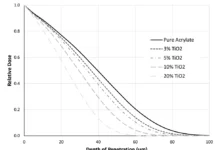By Im Rangwalla, Market Development Manager, Energy Sciences, Inc.
One of the important applications of electron beam processing is curing coatings on surface-printed substrates for various applications, such as outdoor fertilizer bags, candy wrappers and pet food bags.
In each case, the EB coating is designed to replace a laminate – which means replacing a film layer. The EB coating should provide required protection to the inks, the gloss or matte optical finish; abrasion and chemical resistance; and also functional properties such as coefficient of friction (COF). The COF is basically slide angle of the surface of the coated material. In the laminated product, the film provides the desired COF, or slide angle, based upon end-use requirements and as specified by the customer. In packaging where the EB coating replaces the film, the EB coating needs to provide the required COF.
The EB coating, depending on the application, can be designed to provide a range COF.
For example:
High COF – 0.4 to 0.5 for outdoor fertilizer bags
Low COF – 0.18 to .0.22 for candy wrappers
This COF control is important to ensure product performance for downward processing, such as filling, transport and other processes.
In ongoing production, manufacturers are faced with the problem of changing COF caused by the following process variables, which must be controlled.
Dose to cure: Mrads. Consistent degree of cure is important for consistent COF. Dose, defined as the energy absorbed per unit mass having the units of Mrads, is the variable defined to cure the coating. The dose value defines how well the coating is cured to meet its performance targets, for example: gloss, chemical/abrasion resistance and COF. Electrons that are boiled off from a tungsten filament inside a vacuum chamber are accelerated to high velocity. These accelerated electrons then pass through a thin titanium foil to the process zone, which is at atmospheric pressure, inerted by nitrogen gas.
The electrons then strike the product to be cured, moving at a certain speed. The number of electrons or the electron flux striking the EB-curable coating, in this case on a substrate at a certain speed, initiates a polymerization reaction and instantaneously transforms the coating from a liquid to a solid. A combination of the number of electrons arriving at the coating surface at a certain accelerating voltage for the web, with the coating moving at a certain speed, translates to the required dose. Variations in dose lead to different degrees of cure and crosslinking in the coating.
Factors affecting dose are as follows:
- Residue buildup on the foil. This residue is usually from the ink, coating or substrates. As the product is transported through the EB unit to be processed, small amounts of the effluent from the product are deposited inside the process zone, including the foil area. If not cleaned, this residue buildup increases over time, obstructing the pathway of the electrons arriving at the surface of the product to be cured. This obstruction can absorb the electrons and keep them from reaching the product surface – in this case, the coating. This results in a dose lower than the target desired to achieve the degree of crosslinking, resulting in COF variations.
- Routine maintenance of the electron beam involves titanium foil changes and filament changes about once a year. The dose to the product is not usually affected by routine maintenance, but post-maintenance dosimetry is recommended to confirm that the required delivery to the product is consistent – especially after electron gun filament changes.
Inerting: To achieve the desired degree of cure or polymerization for EB curing, oxygen concentration is also very important. Usually the process zone, where the coating meets the electrons and polymerization is initiated, takes place in a nitrogen environment where the oxygen concentration is less than 150 ppm (or as recommended by the chemistry supplier). Higher oxygen concentration leads to oxygen inhibition and lower degree of cure. This lower degree of cure leads to inconsistent COF. In addition, higher oxygen concentration can lead to oxidative groups on the surface that can provide generally higher COF than desired.
Electron beam equipment includes three locations where nitrogen is inserted to maintain the desired oxygen concentration in the process zone at required product speeds. The most important device of nitrogen input is the air knife, or nitrogen input knife.
As the web substrate comes into the process zone with the wet coating – in this case, to be cured with the EB at high speeds more than 1,000 feet per minute – it brings in oxygen molecules sitting on the surface, or the boundary layer. This nitrogen knife is designed to replace the boundary layer oxygen with nitrogen at these high product speeds. Therefore, the aperture, or opening of the knife, and angle distance from the web are extremely important. If the aperture is plugged with coating or substrate effluents, oxygen will be brought into the process zone, affecting degree of cure and thus the COF.
Coat Weight: Weight of the coating also plays an important role in controlling COF. The desired COF is usually achieved by adding different materials – such as waxes, silicones, or similar materials with a certain particle size defined by the required coat weight of the coating on the substrate. If the coat weight changes, and if the coating composition to reflect this change has not been modified, then the COF will be affected. It is important to ensure coat weight, as measured gravimetrically and not as assumed by the anilox size and volume, is as expected.
When facing a problem of varying COF, it is necessary to evaluate and control the three variables to achieve consistent COF. Good manufacturing practices can maintain proper dose, inerting environments and coat weights, resulting in accurate and repeatable COF and successful EB processing.






